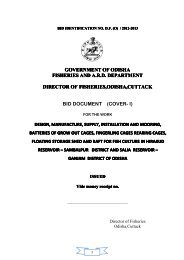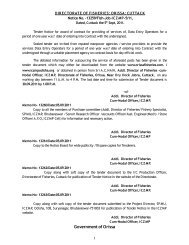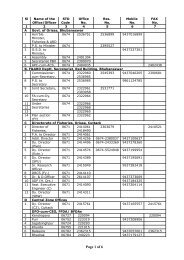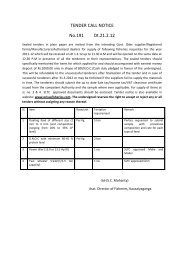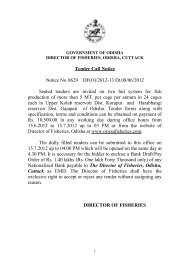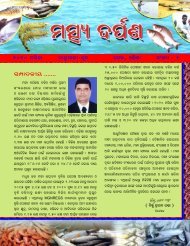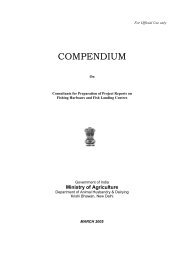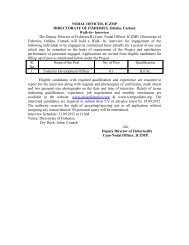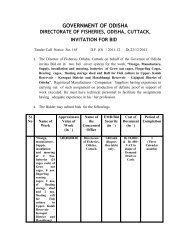Value Chain Analysis of Fishery in Puri and Ganjam District of Orissa
Value Chain Analysis of Fishery in Puri and Ganjam District of Orissa
Value Chain Analysis of Fishery in Puri and Ganjam District of Orissa
You also want an ePaper? Increase the reach of your titles
YUMPU automatically turns print PDFs into web optimized ePapers that Google loves.
Draft Report on “<strong>Fishery</strong> Supply <strong>Cha<strong>in</strong></strong>”<br />
Confidential<br />
Fixed cost depends on<br />
the size <strong>of</strong> operation<br />
<strong>and</strong> the volume <strong>of</strong><br />
trade<br />
Commission / Market cess<br />
/ tax Depend<strong>in</strong>g on the market<br />
Bilty Re. 1-2<br />
Dan Re. 1<br />
Hisabana Re. 1<br />
Cart Rs. 23<br />
Arat collie Rs. 16<br />
Postage Rs. 7<br />
Deposits<br />
Rs.100<br />
Railway bond<br />
Rs.10<br />
C/S fund Re. 0.50<br />
Load<strong>in</strong>g <strong>and</strong> unload<strong>in</strong>g Rs. 50-70 / Q<br />
* All the costs are averages <strong>of</strong> the respondent from the primary study.<br />
8.6 Fish Bone <strong>Analysis</strong><br />
Also called as “Ishikawa diagram”, the fishbone diagram is an analysis tool that provides a<br />
systematic way <strong>of</strong> look<strong>in</strong>g at effects <strong>and</strong> the causes that create or contribute to those effects. It<br />
helps to visually display many potential causes for a specific problem or effect.<br />
Figure 8.1 Fish bone analysis<br />
The analysis has been taken to enhance underst<strong>and</strong><strong>in</strong>g <strong>of</strong> livelihood context <strong>of</strong> the fisherman. The<br />
analysis helps to underst<strong>and</strong> the ‘causes’ that contribute to the effect i.e. ‘poor livelihood’ <strong>of</strong> the<br />
fisherman. The causes that have been observed dur<strong>in</strong>g the ‘quasi participant’ discussions<br />
throughout the primary study are listed below –<br />
1. Exploitation by the supply cha<strong>in</strong><br />
2. Lack <strong>of</strong> Information<br />
3. Poor <strong>in</strong>frastructure<br />
4. Outdated technology<br />
5. Low pric<strong>in</strong>g<br />
6. Social factors<br />
7. Government policy, rules <strong>and</strong> regulation<br />
Exploitation by the supply cha<strong>in</strong><br />
The exploitation <strong>of</strong> the fisherman is prevalent <strong>in</strong> both <strong>Puri</strong> <strong>and</strong> <strong>Ganjam</strong> district by the other<br />
dom<strong>in</strong>ant actors <strong>of</strong> the supply cha<strong>in</strong>. The oligopoly <strong>of</strong> the few middlemen has distorted the<br />
pr<strong>of</strong>itability balance <strong>in</strong> their favour. This has supplemented the distortion <strong>and</strong> <strong>in</strong>equality <strong>in</strong> the<br />
cha<strong>in</strong> <strong>and</strong> reduced the say <strong>of</strong> the fisherman <strong>in</strong> the supply cha<strong>in</strong>.<br />
Submitted by -: NiMble System Pvt. Ltd.<br />
Submitted to -: OXFAM (India) Trust 57



